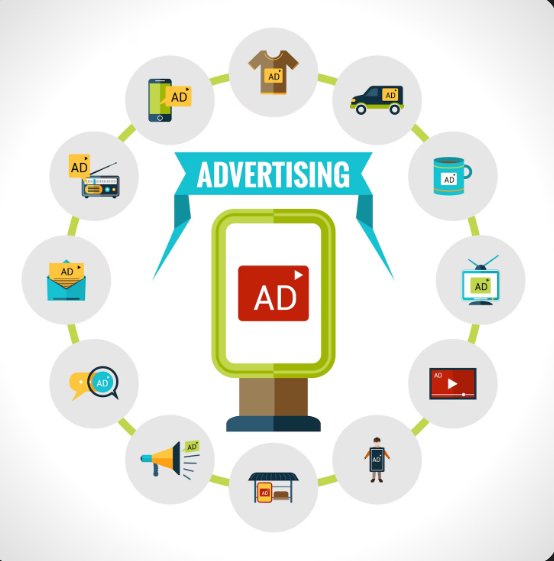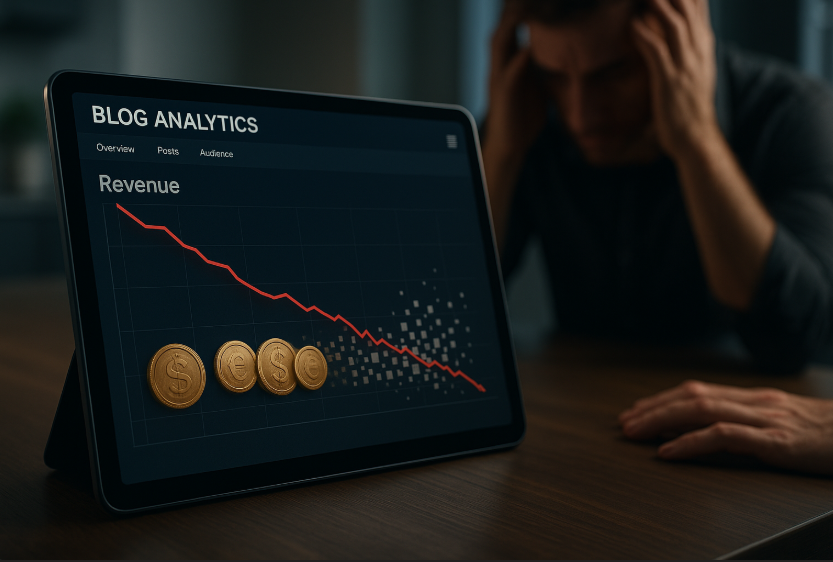The Decline of the Blogging-for-Dollars Model

For nearly three decades, a significant part of the web thrived on a straightforward and lucrative concept:
- Publish some content.
- Add a few ads.
- Cash in.
This “blogging-for-dollars” model fueled the growth of countless niche sites, media empires, and an entire ecosystem of tools and services. However, this once-thriving model, which prioritized generating page views over genuine engagement or product sales, is rapidly collapsing.
The Engine of Ad Revenue

Traffic Sources That Powered the Model
There were three key ways to drive traffic under this model:
- Organic Search (SEO)
- Direct or Type-in Traffic – Especially popular among domain investors, particularly when using typo domains.
- Traffic Arbitrage – This involved purchasing inexpensive traffic from one source (like PPC ads or social media) and directing it to a site lined with higher-paying display ads, hoping for a profitable return.
While this approach wasn’t purely about SEO, it capitalized on the same economic principles—getting traffic cheap while earning more from impressions.
This blogging-for-dollars strategy wasn’t just for hobbyists; it became the backbone of digital publishing, from casual bloggers to major news outlets, where ad revenue drove profits. Over time, the industry became obsessed with pageviews, often sacrificing quality content in the process.
As profit targets increased and margins shrank, publishers began adding more and more advertisements. One banner ad multiplied into six, soon followed by sticky footers, full-page interstitials, video ads, and “recommended content” sections. Readers quickly noticed these changes, and so did Google.
The Trouble with Ad Overload

As audiences developed ‘banner blindness,’ advertisers resorted to aggressive ad formats, relying heavily on JavaScript to bypass ad blockers. This often bloated pages, negatively impacting Core Web Vitals and search engine rankings. And the outcome? Lower traffic and increased pressure to monetize elsewhere. Instead of optimizing, many sites were slowly strangling their income source.
The Shift from Blogging-for-Dollars
The decline of this model can’t be entirely blamed on the rise of easy-to-use publishing tools. Early ad networks with CPM models ignited the trend, with AdSense providing the sparkle. The idea that you could earn substantial money simply by attracting visitors and displaying ads was immensely appealing. Consequently, faster and more efficient publishing systems emerged, catering to the demand for content. This led to the birth of:
- Content spinners
- Auto-blogging tools
- Article marketplaces
- Micro-niche site templates
The Hosting Boom
The demand for cheap, scalable hosting skyrocketed as countless niche sites sprang up to satisfy this craving for content. Hosting companies thrived on volume and managed to offer low prices, but the collapse of the blogging-for-dollars model now forces them to reevaluate their revenue strategies.
Why Is the Blogging-for-Dollars Model Dying?

Decreasing Ad Rates
Ad revenue has steadily declined over the past decade. The golden era of profit margins from high-paying keywords has faded. Rates for clicks (CPCs) and cost per thousands (CPMs) have plummeted, with ad spending shifting focus to video, social media, and direct partnerships instead of long-tail, text-heavy content.
AI and Changing Search Behavior

The rise of AI tools like ChatGPT and Bing Copilot represents a significant structural threat. These technologies provide users with direct answers from multiple sources, often eliminating the need to click on website links. Content that once attracted visitors through long-tail queries, such as “how-to” guides or product comparisons, now faces competition from AI responses.
Audience expectations have shifted as well, favoring quick, concise, and practical information. Pages cluttered with popups and unnecessary fluff have become less appealing, leading to higher bounce rates.
The Cracking Ecosystem
The decline of the blogging-for-dollars model sends shockwaves through a broader ecosystem, impacting various players, including:
Hosting Providers
The hosting sector, reliant on volume from ad-focused sites, must now adapt to the loss of casual site creators. Future customers will be more demanding: eCommerce businesses, brands, and professional content creators seeking reliability and performance rather than the lowest price.
CMSs and Page Builders
Platforms like WordPress won’t disappear, but they are transitioning from a focus on volume to one on stability. While open-source platforms might find some insulation, businesses built around them, such as theme or plugin shops, will struggle without consistent growth.
Ad Networks
The pressure mounts on ad networks as their traditional models falter. They now face tighter margins and heightened expectations from publishers for ad delivery that doesn’t disrupt SEO or site performance. The emphasis must shift towards building sustainable monetization strategies.
What Should SEOs and Publishers Do Now?
If your current strategy revolves around chasing thousands of low-difficulty keywords with ad-filled content, it’s time for a change. Here are some steps to consider:

- Shift from Volume to Value: Focus on creating fewer, high-quality articles that provide real value to readers.
- Build Authority: Authorship, branding, and reputation will be crucial as AI algorithms evolve.
- Diversify Revenue Streams: Explore options beyond display ads, such as affiliate partnerships or premium content.
- Design for Answering Users’ Needs: Structure your content to deliver clear, concise answers, making it easy for users to engage.
The age of easy online income through minimal effort has ended. As AI raises the bar, only sites that can genuinely prove their value will continue to thrive in this evolving landscape. Emphasizing quality over quantity will separate the successful entities from the obsolete ones.


